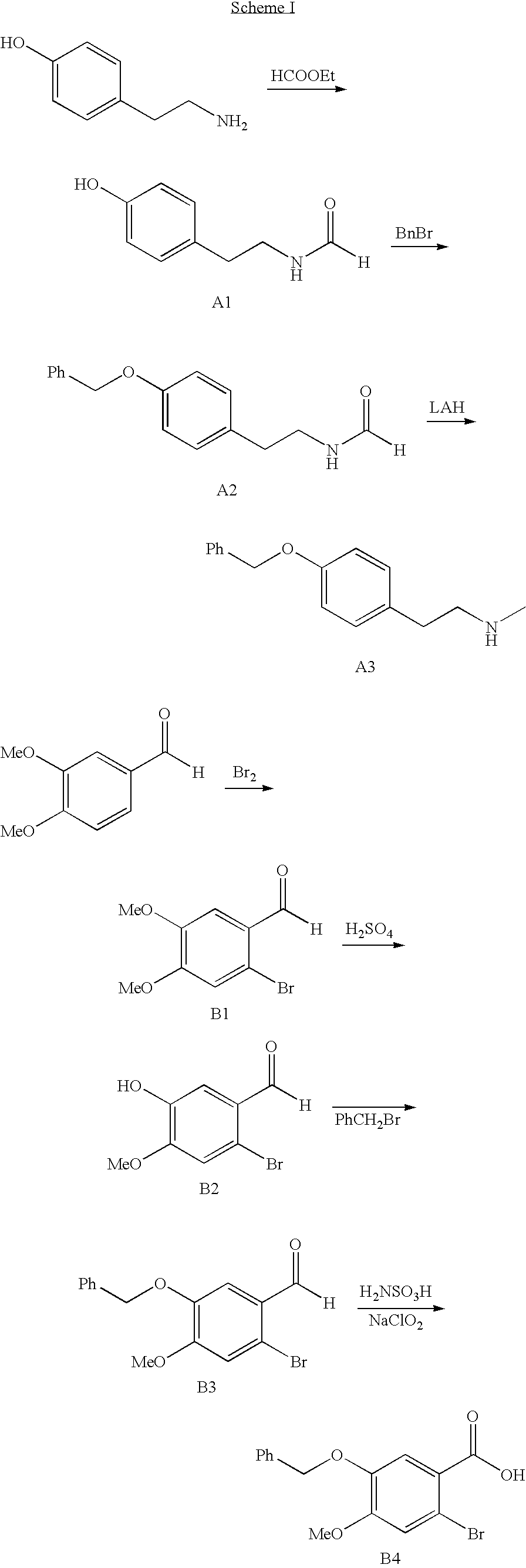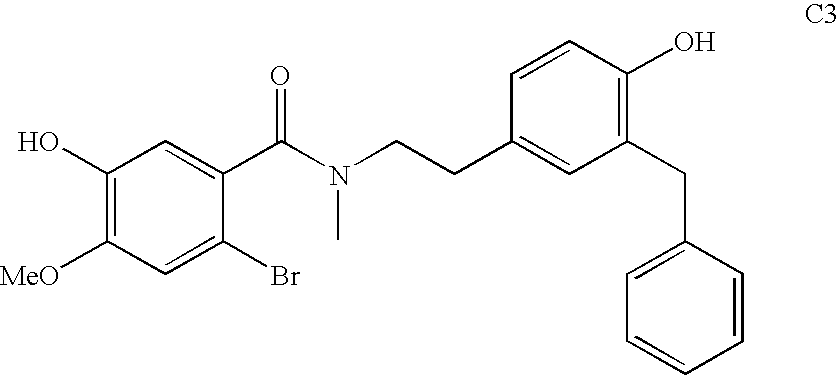Process for making galantamine
a technology of galantamine and process, applied in the field of making galantamine, can solve the problems of low and inconsistent yield of desired product, difficult to remove impurities from product, etc., and achieve the effects of simple, short, relatively inexpensive and highly efficient synthesis
- Summary
- Abstract
- Description
- Claims
- Application Information
AI Technical Summary
Benefits of technology
Problems solved by technology
Method used
Image
Examples
example 1
(2-[4-hydroxyphenyl]ethyl) bromide (A11)
[0048]
[0049]500 g 2-(4-hydroxyphenyl)ethanol was placed in a 5 L round bottom flask, to which 2960 g of 48% aq. HBr was added with stirring. The reaction mixture was placed in a bath at 75° C. After 2.5 h agitation 5 g of A11 seed crystals was added. The reaction mixture was stirred at this temperature for another 24 h. The reaction mixture was slowly cooled to 20° C. The precipitate was isolated by filtration and washed with 10% aq. sodium bicarbonate solution to give 700 g (96% yield) of the title product. 1H NMR (CDCl3); δ 3.10 (2H, t, J=7.8 Hz), 3.53 (2H, t, J=7.5 Hz), 6.80 (2H, d, J=8.4 Hz), 7.09 (2H, d, J=8.4 Hz).
(2-[4-hydroxyphenyl]ethyl)chloride
[0050]
[0051]In a similar process using 12N HCl, 2-(4-hydroxyphenyl)ethanol gave 70% isolated yield of the (2-[4-hydroxyphenyl]ethyl) chloride. 1H NMR (CDCl3) δ 2.96 (2H, t, J=7.8 Hz), 3.67 (2H, t, J=7.2 Hz), 6.79 (2H, d, J=8.4 Hz), 6.94 (2H, d, J=8.1 Hz)
example 2
N-methyl-N-(2-[4-hydroxyphenyl]ethyl) amine HBr (A12 HBr)
[0052]
[0053]1000 mL of IPA was placed in a 3 L flask and cooled to 0° C. A steady stream of methylamine gas from a cylinder was slowly passed through the IPA until the total volume reached 1750 ml. 100 g of (2-[4-hydroxyphenyl]ethyl) bromide (A11) was added to the cooled methylamine IPA solution in several portions. The cooling bath was removed after all A11 was added. The reaction mixture was allow to warm to room temperature and continue to stir for another 10-12 h. The excess methylamine was distilled into another 1000 mL of pre-cooled to 0° C. IPA by heating the reaction mixture at 50° C. When most of the methylamine was distilled off, the bath temperature was raised to 100° C. and the IPA was distilled out. After most of the IPA had been distilled out, about 300 mL of IPA was added to the reaction mixture and distillation was continued to aid removal of the methylamine. After the volume was reduced to 250 mL, the reaction...
example 3
2-bromo-5-hydroxy-4-methoxy benzoic acid (B13)
[0054]
[0055]1 Kg of 2-bromo-5-hydroxy-4-methoxy benzaldehyde (B2) and 1.255 Kg of sulfamic acid were added with stirring into a mixture of 4.473 Kg of EtOAc and 8 L of water. The reaction mixture was stirred until all of the solid had dissolved. The reaction mixture was cooled to between −10 and 0° C. An aqueous solution of sodium chlorite was prepared by dissolving 505 g of sodium chlorite in 3 L of water. The sodium chlorite solution was added to the pre-cooled B2 solution at a rate that maintained the reaction temperature under 5° C. After the complete addition of sodium chlorite solution, the reaction mixture was stirred for another hour at 0° C. and was then allowed to warm up to room temperature. The reaction was monitored by TLC. After the TLC analysis showed completion of the reaction, the aqueous layer was separated. The aqueous layer was extracted with EtOAc (1.789 Kg) and the combined organic layer was transferred to another f...
PUM
| Property | Measurement | Unit |
|---|---|---|
| Temperature | aaaaa | aaaaa |
| Temperature | aaaaa | aaaaa |
| Acidity | aaaaa | aaaaa |
Abstract
Description
Claims
Application Information
 Login to View More
Login to View More - R&D
- Intellectual Property
- Life Sciences
- Materials
- Tech Scout
- Unparalleled Data Quality
- Higher Quality Content
- 60% Fewer Hallucinations
Browse by: Latest US Patents, China's latest patents, Technical Efficacy Thesaurus, Application Domain, Technology Topic, Popular Technical Reports.
© 2025 PatSnap. All rights reserved.Legal|Privacy policy|Modern Slavery Act Transparency Statement|Sitemap|About US| Contact US: help@patsnap.com



